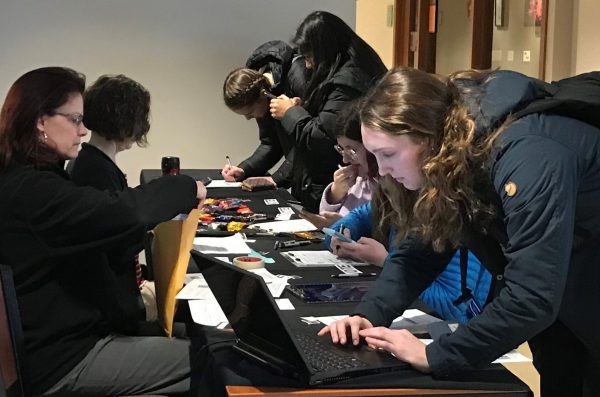
community with new-voter registration, the mailing of absentee ballots, rides
to the polls, and the distribution of candidate information and maps to local
polling places in 2020, boosting K to a voter turnout rate of 83.7 percent.
Kalamazoo College eclipsed national averages for voter turnout in 2020 as 83.7 percent of the student body cast ballots in last year’s presidential election. For that achievement, the Institute of Democracy and Higher Education (IDHE) at Tufts University has awarded K its platinum seal in the All-In Democracy Challenge, marking the colleges who achieved voter-participation rates of 80 to 89 percent.
K is the only campus in Michigan and one of 48 out of about 1,200 participating institutions nationwide to receive the honor. That puts K in the top 4 percent of colleges and universities in the country for its voter turnout among the institutions reporting. The primary cause for the outstanding benchmark at the polls, according to IDHE, is unclear. However, Center for Civic Engagement (CCE) Director Alison Geist credited K Votes, the CCE’s non-partisan coalition to inform the College’s students, faculty and staff members about voting and civic engagement, for its efforts in boosting the College’s voter participation.
Based on a look at incomplete data for 2016, K’s student voting rate was estimated at 54.1 percent, which was in line with that year’s national average. But in 2020, K Votes representatives worked in partnership with their student peers, the local League of Women Voters and the national Rock the Vote organization, which is led by Executive Director Caroline DeWitt ’04, a K alumna. Those partnerships helped K Votes provide services such as new-voter registration, the mailing of absentee ballots, rides to the polls, and the distribution of candidate information and maps to local polling places.
“I am proud of K’s students, especially the CCE’s K Votes Civic Engagement Scholars, Kaitlyn Dexter and Mahum Khan,” Geist said. “They were so ably led by then-Assistant Director Emily Kowey ’17, whose dedication and creativity, in the midst of a pandemic, drove the College’s impressive turnout and registration rates in the 2020 election. Voting is but a small part of what we mean by civic engagement, but it is essential to our communities and democracy, and it seems particularly so as voting rights are increasingly under siege.”
The IDHE’s report, titled the National Study of Learning, Voting and Engagement (NSLVE), notes the national average of voting rates was 66 percent this year, putting K well above it. However, the report also shows K must continue to encourage students of color to vote, as their participation rates generally trailed those of white students. About 53 percent of K’s Asian students, and 66 percent of Black and Hispanic students voted in 2020 compared with 88 percent of white students.
The NSLVE is the nation’s largest study of college and university student voting. It measured voter turnout at campuses ranging from community colleges to research universities, women’s colleges, historically Black colleges, state universities and private schools. The dataset reflects all 50 states and the District of Columbia, includes 49 of the nation’s 50 flagship schools and tracks nearly 8.9 million voting-eligible students.
“That students, often younger and first-time voters, turned out at rates commensurate with the general public in 2020 is nothing short of stunning,” IDHE Director Nancy Thomas said. “We attribute this high level of participation to many factors, including student activism on issues such as racial injustice, global climate change and voter suppression, as well as increased efforts by educators to reach students and connect them to the issues and to voting resources.”
